Abstract
A low-infrared-emissivity composite coating with outstanding mechanical properties and low glossiness was prepared by using an epoxy resin and polyurethane blend modified resin, flake brass powder, the silane coupling agent KH560, and a dispersant as an adhesive, a functional pigment, and interface modifiers, respectively. The effects of the mass ratios of epoxy resin and polyurethane, the addition amount of flake brass powder, the addition amount of KH560, and the addition amount of dispersant on the coating performance were systematically discussed. The results show that the coating has lower emissivity (0.424) and glossiness (28.8) when the mass ratio of epoxy resin to polyurethane is 6:4 and the addition amount of brass powder is 50 wt%. Using KH560 to modify the interface structure of the coating, KH560 can form chemical bond with the resin matrix and flake brass powder so as to obviously improve the impact strength and flexibility of the coating. The addition of the dispersant can obviously enhance the dispersion state of the flake brass powder in the coating and thus enhance the reflection intensity of infrared light for the coating, such that the emissivity of the coating is obviously reduced. When the addition amount of KH560 is 7 wt% and the addition amount of the dispersant is 9 wt%, the coating has the optimal emissivity (0.332), glossiness (9.0), adhesion strength (grade 1), impact strength (50 kg·cm), and flexibility (1 mm) at the same time. The above mentioned low-infrared-emissivity coating has an important application prospect in the field of infrared stealth for various aircraft.
1. Introduction
The infrared emissivity of a resin/flake metal composite coating can be as low as 0.4, which can provide excellent infrared stealth performance. It has the advantages of a simple preparation method, convenient use, and no influence on the target shape and structure. It is expected to achieve large-scale engineering applications in the process of stealth design and transformation of various aircraft, so it has attracted the attention of many researchers in the field of coating [1,2,3,4,5]. Currently, the most used resin bases in the field of low-infrared-emissivity coatings are polyurethane and epoxy resin [6,7,8]. These two commonly used resins have their own advantages and disadvantages. Epoxy resin has outstanding bonding strength and corrosion resistance, but a coating prepared from epoxy resin is relatively brittle, so its flexibility and impact strength are relatively low, which has an adverse effect on its engineering application [9,10]. Polyurethane has the advantages of high hardness, wear resistance, radiation resistance, and peel strength, but the corrosion resistance and temperature resistance of coatings prepared from polyurethane are relatively poor [11,12]. Blending modification using multiple resins is an effective technical means to improve the comprehensive performance of coatings. The method of blending modified epoxy resin with fluorocarbon resin can improve the wear resistance and corrosion resistance of an epoxy resin-based corrosion-resistant functional composite coating [13]. The method of blending modified polyvinyl butyral with phenol formaldehyde resin can improve the friction resistance and corrosion resistance of a polyvinyl butyral resin-based corrosion-resistant functional composite coating [14]. The wear behavior, impact resistance, flexibility, and other engineering properties of a resin-based composite coating can be significantly improved by blending epoxy resin and polyurethane [15,16]. In addition, adding a silane coupling agent to the composition of the material formula can significantly improve the multiple engineering application properties of resin-based composite materials and composite coatings [17,18,19]. Adding a dispersant to the coating can significantly improve the dispersion state of various types of functional filler particles in the resin-based composite coating, and thus the comprehensive properties of resin matrix composite coatings can be improved [20,21].
In view of this, in this paper, an epoxy resin and polyurethane blend modified resin matrix is used as a binder, and conductive flake brass powder is used as a low-infrared-emissivity functional pigment to prepare a low-infrared-emissivity coating. Brass powder has good electrical conductivity, which is beneficial to achieving low emissivity. In addition, the brass powder has a yellowish-brown color, which is good for the visible light camouflage of the coating. The effects of the KH560 and dispersant on the interface structure, optical, adhesion strength, flexibility, and impact resistance properties of the epoxy resin and polyurethane blend resin-based composite coating were also studied. Through the blending of epoxy resin and polyurethane, as well as the multiple interface modifications of the KH560 and dispersant, the coating prepared in this paper has excellent low-infrared-emissivity and mechanical properties. It has broad application prospects in the field of infrared camouflage of various kinds of equipment.
2. Materials and Methods
2.1. Materials
Brass powder (purity 99 wt%, flake, 20–60 µm), epoxy resin (effective ingredients 45 wt%), polyurethane (effective ingredients 43 wt%), silane coupling agent (KH560 γ-glycidoxypropyltrimethoxysilane, purity 99 wt%), dispersant (sodium polycarboxylate salt, purity 99 wt%), and tinplate (12 cm × 5 cm × 0.28 mm) were purchased from the NSPL Company, Nanjing, China. All reagents were used directly without prior treatment.
2.2. Coating Preparation
Based on the coating preparation method previously reported by our research group [22], the coating preparation process described in this paper is as follows. The standard tinplate was polished with sandpaper and wiped with alcohol before use. Epoxy resin and polyurethane were blended in different mass ratios (0:10, 2:8, 4:6, 6:4, 8:2, 10:0) and used as adhesives. Then, according to a mass ratio of blended modified resin and flake brass powder of 6:4, resin matrix and flake brass powder were weighed and placed in a plastic cup. Some absolute ethanol was added and stirred thoroughly to disperse the flake brass powder in the mixture. Then, the paint was treated with ultrasonic waves with a frequency of 25 KHz for 10 min so that it was dispersed thoroughly and the appearance of the paint was exquisite. Then, a certain amount of absolute ethanol was added to reduce the viscosity of the paint so that the paint could flow down continuously. Following that, 1–2 g of paint was poured onto the surface of the prepared tinplate and evenly scraped onto the tinplate with a glass rod. The sample was dried naturally at normal atmospheric temperature for 3 h; it was then cross-linked and cured at 80 °C for 3 h to prepare the low-emissivity coating sample for testing. Under the conditions of the above optimum mass ratio of epoxy resin and polyurethane, the influence of the flake brass powder addition (20–50 wt%) on the properties was studied by the same coating preparation method, and the optimal addition amount of brass powder was obtained. Then, under the conditions of the above optimum brass powder addition amount, the influence of the addition amount of KH560 (1–9 wt%) on the properties was studied, and the optimal addition amount of KH560 was obtained. Then, under the conditions of the above optimal KH560 addition amount, the influence of the dispersant addition amount (1–9 wt%) on the coating performance was studied to obtain the optimal dispersant addition amount. The preparation process of the epoxy resin and polyurethane blend resin-based composite coating is presented in Figure 1.
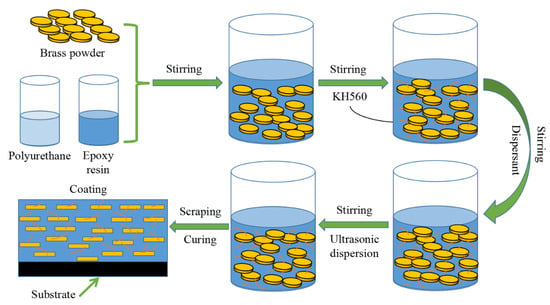
Figure 1.
Preparation process of the coating.
2.3. Characterization
The surface morphology of the epoxy resin and polyurethane blend resin-based composite coating was measured by scanning electron microscopy (Japan Electronics Corporation, Tokyo, Japan). The infrared emissivity (8–14 μm) of the epoxy resin and polyurethane blend resin-based composite coating was measured by an infrared emissometer (Shanghai Institute of Technological Physics, Shanghai, China); the standard deviation of infrared emissivity was ±0.005. The glossiness of the epoxy resin and polyurethane blend resin-based composite coating was measured by a glossiness tester (Tianjin Jingkelian Material Testing Machine Co., Ltd., Tianjin, China); the standard deviation of glossiness was ±0.1. The adhesion strength, flexibility, and impact strength of the epoxy resin and polyurethane blend resin-based composite coating were tested according to the methods described in GB 1720-79(89), GB 1731-93, and GB 1732-93, respectively. The adhesion strength index includes 1–7 grades; from grade 1 to 7, the adhesion strength gets worse and worse. The standard deviation of adhesion strength is ±1 grade. Flexibility measures the degree to which a paint film can bend and deform. The curvature diameter (mm) is used to measure the flexibility, the smaller the diameter the higher the flexibility. The standard deviation of flexibility was ±1 mm. During the impact strength test, the coating was impacted by a 1 kg hammer falling from a certain height, and the intactness degree of the coating was used to evaluate whether the coating can withstand the impact from the corresponding height. The index unit of impact strength is kg·cm, the standard deviation was ±1 kg·cm, and the larger the value, the higher the impact strength.
3. Results and Discussion
3.1. Effect of Mass Ratios of Epoxy Resin to Polyurethane on Coating Properties
Figure 2 shows the SEM photos of the epoxy resin and polyurethane blend resin-based composite coatings with mass ratios of epoxy resin to polyurethane of 2:8 and 6:4. It can be seen that the mass ratios of epoxy resin to polyurethane have no effect on the microstructure. When the mass ratios of epoxy resin to polyurethane are 2:8 and 6:4, all the coatings have regular surface structures and smooth surfaces. Flake brass powders are evenly dispersed, the diameter of the brass powder is different, and there are many gaps between brass powder particles; these gaps are completely filled by the resin matrix. In addition, the flake brass powder is almost laid flat, and its horizontal orientation is almost parallel to the surface. The regular surface microstructure and the horizontal orientation of the flake brass powder can enhance the reflection by the coating of infrared radiation, so the coating may exhibit lower emissivity [22]. However, the smooth coating surface means it is easy to make the coating exhibit strong reflection of visible light, which may make the coating show high-glossiness characteristics [23].
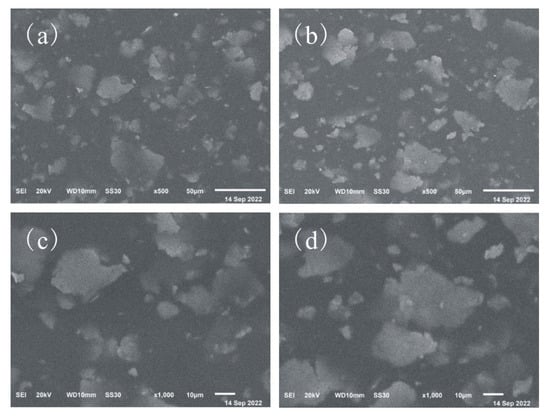
Figure 2.
SEM photos of coatings under the mass ratios of epoxy resin to polyurethane of 2:8 (a,c) and 6:4 (b,d).
Table 1 shows the optical and mechanical properties of the epoxy resin and polyurethane blend resin-based composite coatings under different mass ratios of epoxy resin to polyurethane. The data show that the emissivity and glossiness of the coatings prepared under different mass ratios of epoxy resin to polyurethane do not have obvious change rules. The emissivity and glossiness can be adjusted in the range of 0.475–0.519 and 45.8–56.0, respectively. The reason is that the emissivity mainly depends on the content of conductive flake metal powder in the coating formulation [22]; the content of brass powder in different coatings prepared under different mass ratios of epoxy resin to polyurethane is fixed at 40 wt%, so the variation in emissivity of the above coatings is limited. The glossiness is mainly affected by the smoothness of the coating surface: the higher the smoothness of the coating, the greater the glossiness [23]. According to the SEM results of the coating surface, when the content of flake brass powder is 40 wt%, the surface morphology of the coating is very smooth, so the glossiness is generally high.

Table 1.
Performance index of coatings under different mass ratios of epoxy resin to polyurethane.
From Table 1, it can be seen that under the conditions of different mass ratios of epoxy resin and polyurethane, the adhesion strength of the prepared coatings can reach grade 1. The results show that a coating prepared with the resin modified by blending epoxy resin and polyurethane has outstanding adhesive strength with the substrate. When the mass ratio of epoxy resin to polyurethane increases from 2:8 to 8:2, the flexibility of the coating becomes worse, and its value can be lessened from 4 mm when the mass ratio is 2:8 to 7 mm when the mass ratio is 8:2. The above results show that when the relative content of epoxy resin in the resin matrix is high, the flexibility of the coating is relatively poor. In addition, under different mass ratios of epoxy resin to polyurethane, the impact strength of the coating can reach 40 kg·cm, which is still far from the optimal level of 50 kg·cm. Therefore, it is necessary to further optimize the formulation of the epoxy resin and polyurethane blend resin-based composite coating to improve the flexibility and impact strength. Through the above discussion, the optimum mass ratio of epoxy resin to polyurethane is determined to be 6:4.
3.2. Effect of Brass Powder Content on Coating Properties
The mass ratio of epoxy resin to polyurethane was fixed at 6:4, and the effect of the addition amount of brass powder on the properties of the epoxy resin and polyurethane blend resin-based composite coating was analyzed. The SEM images of the coatings are shown in Figure 3. It can be seen that the addition amount of brass powder can obviously affect the surface morphology. When the content of brass powder is 20 wt%, the vast majority of the formula components in the coating is organic resin. The coverage of brass powder on the coating surface is very low, and there are a large number of gaps filled by the resin matrix between the brass powder particles. At this time, the coating mainly shows the characteristics of the resin matrix, and the surface state is very smooth. The structural characteristics of the thick resin layer on the surface will play a negative role in reducing the emissivity of the coating and its strong reflection of visible light; therefore, the coating may have high emissivity and glossiness performance [22,23]. As the content of brass powder in the coating increases from 20 wt% to 50 wt%, the characteristics of flake brass powder are more obvious, and its coverage is obviously improved. In addition, when the brass powder content is controlled within 50 wt%, the change in brass powder content did not significantly affect its dispersion, and the gaps between the brass powder particles are significantly reduced when the brass powder content is increased. The resin layer characteristics on the coating surface are obviously weakened, and the smoothness is obviously reduced. These microstructural characteristics are helpful to enhancing the reflection intensity of infrared radiation and reducing the reflection intensity of visible light at a higher content of flake brass powder. Therefore, a coating with a higher brass powder content may has lower emissivity and glossiness performance [22,23].
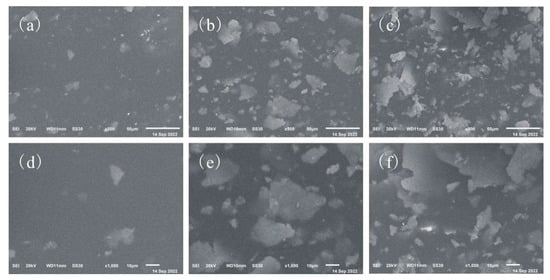
Figure 3.
SEM images of coatings with contents of brass powder of 20 wt% (a,d), 40 wt% (b,e), and 50 wt% (c,f).
Table 2 shows the optical and mechanical properties of the epoxy resin and polyurethane blend resin-based composite coatings under different contents of brass powder. The data show that the emissivity was obviously reduced when the brass powder content increased from 20 wt% to 50 wt%. When the brass powder content increased from 20 wt% to 50 wt%, the emissivity was reduced from 0.588 to 0.424, a reduction of 27.9%. The glossiness of the corresponding coating was also obviously reduced. When the brass powder content increased from 20 wt% to 50 wt%, the glossiness was obviously reduced from 73.5 to 28.8, a reduction of 60.8%. The reason can be described as follows: when the brass powder content increases from 20 wt% to 50 wt%, the characteristics of the resin layer are weakened, the coverage of flake brass powder is increased, and the roughness of the coating increases significantly. Thus, the reflective intensity of the coating for infrared light increases, and the reflective intensity for visible light decreases; finally, the emissivity and glossiness decrease simultaneously.

Table 2.
Performance index of coatings with different contents of brass powder.
From Table 2, it can be seen that the adhesion strength is grade 1 under different addition amounts of brass powder. The flexibility of the coating can reach 4 mm when the brass powder content is 50 wt%, and it is 5 mm under other conditions, so there is much room for improvement. The main reason is that flake brass powder has a good deformation property. Adding more flake brass powder to the coating can significantly reduce the brittleness caused by epoxy resin, so the coating can show better flexibility when the content of flake brass powder is high. The impact strength can reach 45 kg·cm under different addition amounts of flake brass powder, and there is still some room for improvement. Through the above discussion, the optimum brass powder content is determined to be 50 wt%.
3.3. Effect of KH560 Content on Coating Properties
In order to improve the flexibility and impact strength, the mass ratio of epoxy resin to polyurethane was fixed at 6:4, and the content of brass powder was fixed at 50 wt%. The effect of the content of KH560 in the coating formulation on the properties of the epoxy resin and polyurethane blend resin-based composite coating was studied. Figure 4 shows the SEM photos of the epoxy resin and polyurethane blend resin-based composite coatings with addition amounts of KH560 of 0 wt% and 7 wt%. This shows that after adding KH560 to the coating formulation, the shrinkage stress of the coating is enhanced because the cross-linking curing degree of the resin is improved, so the characteristics of flake brass powder in the coating are more obvious. However, due to the increased shrinkage stress of the coating, the horizontal orientation characteristics of the flake brass powder are weakened, and the surface smoothness of the coating is reduced. These microstructure changes may increase the emissivity, but the decrease of the surface smoothness of the coating is expected to obviously decrease the glossiness.
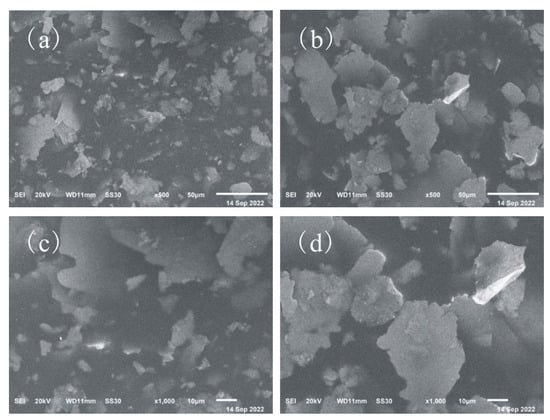
Figure 4.
SEM photos of coatings with contents of KH560 of 0 wt% (a,c) and 7 wt% (b,d).
Table 3 shows the optical and mechanical properties of the epoxy resin and polyurethane blend resin-based composite coatings with different addition amounts of KH560. It can be seen that with the increase of KH560, the emissivity generally shows an upward trend. The emissivity can be increased from 0.424 without KH560 to 0.518 with 9 wt% KH560. However, the glossiness of the coating shows a downward trend with the increase of KH560. The glossiness can be reduced from 28.8 without KH560 to 6.0 with 9 wt% KH560. The main reason lies in the polar groups in the molecular structure of KH560, which can cause the absorption of infrared light, so the emissivity will rise slightly [22]. In addition, after KH560 modification, due to the shrinkage stress of the resin matrix, the horizontal orientation of the flake brass powder weakens, which reduces the effective reflection of infrared radiation, thus increasing the emissivity of the epoxy resin and polyurethane blend resin-based composite coating. However, the shrinkage stress of the resin matrix increases the surface roughness, thus obviously reducing the glossiness when KH560 is added into the coating formulation.

Table 3.
Performance index of coatings with different contents of KH560.
From Table 3, it can be seen that KH560 can play a significant positive role in improving the mechanical properties of a coating. After adding 5 wt% KH560 into the coating, the flexibility significantly improved from 4 mm before modification to 1 mm after modification. When only 1 wt% KH560 is added into the coating, the impact strength increases from 45 kg·cm before modification to 50 kg·cm after modification. In addition, with the increase of KH560 content, the adhesion strength of the coating remains unchanged at grade 1. The reason is that the silane coupling agent KH560 can play an obvious bridging role; a large number of methoxy groups in the molecular structure can form coordination bonds with metal atoms, and epoxy groups can combine with hydroxyl and amino groups in the resin matrix, which can significantly improve the interface bonding strength between the organic resin and flake brass powder (Figure 5). Finally, the flexibility and impact strength of the epoxy resin and polyurethane blend resin-based composite coating were significantly improved after KH560 was introduced into the coating formulation. Through the above discussion, the optimum addition amount of KH560 is determined to be 7 wt%.
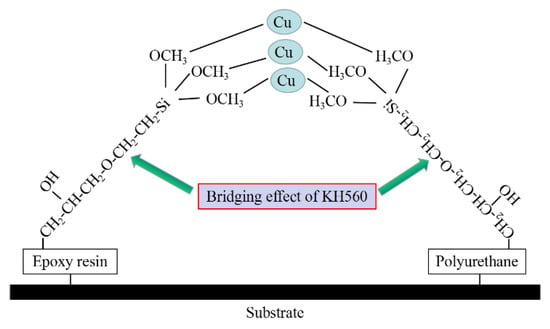
Figure 5.
Schematic for the bridging effect of KH560.
3.4. Effect of Dispersant Content on Coating Properties
Further reducing the emissivity and glossiness of the epoxy resin and polyurethane blend resin-based composite coating has a positive significance for further improving its stealth properties. Therefore, this part further adopts the method of dispersant modification to optimize the emissivity and glossiness of the coating. The mass ratio of epoxy resin to polyurethane was fixed at 6:4, the brass powder content was fixed at 50 wt%, and the KH560 content was fixed at 7 wt%. The effect of the dispersant content on the properties of the epoxy resin and polyurethane blend resin-based composite coating was studied. Figure 6 shows the SEM photos of epoxy resin and polyurethane blend resin-based composite coatings with addition amounts of dispersant of 0 wt% and 9 wt%. It can be seen that when a certain amount of dispersant is added to the epoxy resin and polyurethane blend resin-based composite coating, the agglomeration of the flake brass powder is obviously weakened, and the dispersion state is obviously improved. From the coating’s surface, the distinctive characteristics of the flake brass powder can be observed. The characteristics of the resin layer in the coating were significantly weakened, and the gaps filled by epoxy resin and polyurethane were also obviously reduced. In addition, the horizontal orientation of the flake brass powder in the dispersant-modified epoxy resin and polyurethane blend resin-based composite coating is well maintained. These microstructural characteristics are conducive to making the epoxy resin and polyurethane blend resin-based composite coating achieve lower emissivity.
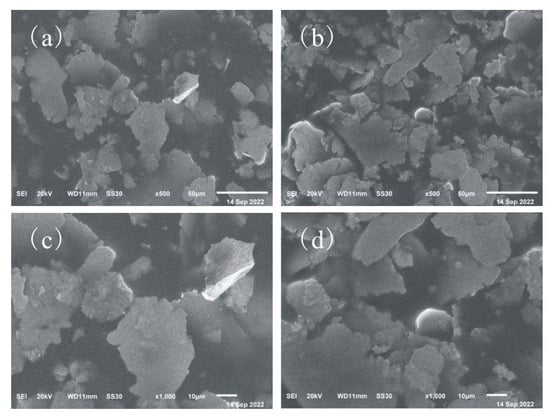
Figure 6.
SEM images of coatings with contents of dispersant of 0 wt% (a,c) and 9 wt% (b,d).
Table 4 shows the optical and mechanical properties of epoxy resin and polyurethane blend resin-based composite coatings with different addition amounts of dispersant. It can be seen that the emissivity decreases with the increase of the addition amount of the dispersant. When the addition amount of the dispersant increased to 9 wt%, the emissivity remained stable. When the addition amount of the dispersant increased from 0 wt% to 9 wt%, the emissivity obviously decreased from 0.486 to 0.332, a reduction of 31.7%. Following that, the emissivity change was very limited as the addition amount of dispersant continued to increase. The glossiness of the corresponding coatings decreased first and then increased, but the glossiness of the coatings was lower than 10.5 with different addition amounts of dispersant, which showed obvious low-glossiness characteristics. The main reason is that when a small amount of dispersant is added to the coating formulation, the characteristics of the epoxy resin and polyurethane blend resin are weakened, and the surface smoothness is reduced, thus reducing the glossiness. When the dispersant content increases from 1 wt% to 13 wt%, the characteristics of the flake brass powder in the coating are more obvious, and the metallic luster of the flake metal powder is shown, which makes the glossiness of the coating rise again.

Table 4.
Performance index of coatings with different addition amounts of dispersant.
From Table 4, it can be seen that adding different contents of dispersant to the epoxy resin and polyurethane blend resin-based composite coating has no effect on the mechanical properties. All the mechanical properties of the coating are insensitive to modification with the dispersant. The adhesion strength, impact strength, and flexibility under different addition amounts of dispersant are maintained at grade 1, 50 kg·cm, and 1 mm, respectively. Through the above discussion, the optimum addition amount of the dispersant is determined to be 9 wt%.
4. Conclusions
Using an epoxy resin and polyurethane blend modified resin, flake brass powder as a pigment, KH560, and a dispersant as initial raw materials, a low-emissivity coating with excellent mechanical properties and low glossiness was successfully prepared. The mass ratio of epoxy resin and polyurethane has an obvious effect on the flexibility but has little effect on other optical and mechanical properties. When the content of the flake brass powder increases from 20 wt% to 50 wt%, the emissivity and glossiness obviously decrease, but the influences on the mechanical properties are limited. After KH560 modification, the glossiness is obviously reduced, and the impact strength and flexibility are obviously improved. When the content of the dispersant increases from 1 wt% to 9 wt%, the emissivity obviously decreases from 0.488 to 0.332, while the glossiness, adhesion strength, impact strength, and flexibility are kept in the best state. When the mass ratio of epoxy resin to polyurethane is 6:4, the addition amounts of flake brass powder, KH560, and dispersant are 50 wt%, 7 wt%, and 9 wt%, respectively. The epoxy resin and polyurethane blend resin-based composite coating has the optimal emissivity (0.332), glossiness (9.0), adhesion strength (grade 1), impact strength (50 kg·cm), and flexibility (1 mm) at the same time. Thus, the coating can well meet the engineering application requirements of various types of equipment for infrared stealth coating.
Author Contributions
Conceptualization, methodology, validation, and resources, J.Z.; writing—review and editing, W.Z.; data management and supervision, Q.G.; formal analysis, X.L.; investigation, D.L. All authors have read and agreed to the published version of the manuscript.
Funding
This project was sponsored by the National Natural Science Foundation of China (61705029), Key Projects of the Excellent Young Talents Support Plan in Universities of Anhui Province (gxyqZD2020044), Science and Technology Major Special Project of Anhui Province (202103a05020018), and Student Innovation Training Program Project of Chuzhou University (2022CXXL2050107).
Institutional Review Board Statement
Not applicable.
Informed Consent Statement
Not applicable.
Data Availability Statement
Not applicable.
Conflicts of Interest
The authors declare that there is no conflict of interest.
References
- Lyu, J.; Liu, Z.W.; Wu, X.H.; Li, G.Y.; Fang, D. Nanofibrous kevlar aerogel films and their phase-change composites for highly efficient infrared stealth. ACS Nano 2019, 13, 2236–2245. [Google Scholar] [CrossRef] [PubMed]
- Phan, L.; Walkup IV, W.G.; Ordinario, D.D.; Karshalev, E.; Jocson, J.M.; Burke, A.M.; Gorodetsky, A.A. Reconfigurable infrared camouflage coatings from a cephalopod protein. Adv. Mater. 2013, 25, 5621–5625. [Google Scholar] [CrossRef] [PubMed]
- Chen, X.T.; Zhou, M.; Zhao, Y.; Gu, W.H.; Wu, Y.; Tang, S.L.; Ji, G.B. Morphology control of eco-friendly chitosan-derived carbon aerogels for efficient microwave absorption at thin thickness and thermal stealth. Green Chem. 2022, 24, 5280–5290. [Google Scholar] [CrossRef]
- Solovyev, A.A.; Rabotkin, S.V.; Kovsharov, N.F. Polymer films with multilayer low-E coatings. Mater. Sci. Semicon. Proc. 2015, 38, 373–380. [Google Scholar] [CrossRef]
- Wang, L.; Xu, G.; Liu, C.; Hou, H.; Tan, S. Surface-modified CeO2 coating with excellent thermal shock resistance performance and low infrared emissivity at high-temperature. Surf. Coat. Technol. 2019, 357, 559–566. [Google Scholar] [CrossRef]
- Yan, X.X.; Xu, G.Y. Influence of silane coupling agent on corrosion-resistant property in low infrared emissivity Cu/polyurethane coating. Prog. Org. Coat. 2012, 73, 232–238. [Google Scholar] [CrossRef]
- Liu, Z.; Ban, G.; Ye, S.; Liu, W.; Liu, N.; Tao, R. Infrared emissivity properties of infrared stealth coatings prepared by water-based technologies. Opt. Mater. Express 2016, 6, 3716–3724. [Google Scholar] [CrossRef]
- Zhang, W.G.; Ma, Z.W.; Lv, D.D.; Luo, J.W.; Li, J. An ultra-low infrared emissivity composite coating with outstanding mechanical properties and salt water resistance. Infrared Phys. Technol. 2022, 126, 104351. [Google Scholar] [CrossRef]
- Ma, L.L.; Liu, H.; Wen, X.; Szymanska, K.; Mijowska, E.; Hao, C.C.; Tang, T.; Lei, Q.Q. Polyhydric SiO2 coating assistant to graft organophosphorus onto glass fabric for simultaneously improving flame retardancy and mechanical properties of epoxy resin composites. Compos. Part B Eng. 2022, 243, 110176. [Google Scholar] [CrossRef]
- Conradi, M.; Kocijan, A.; Kek-merl, D.; Zorko, M.; Verpoest, I. Mechanical and anticorrosion properties of nanosilica-filled epoxy-resin composite coatings. Appl. Surf. Sci. 2014, 292, 432–437. [Google Scholar] [CrossRef]
- Zhang, W.G.; Xiong, S.; Lv, D.D. Preparation and characterization of hydrogen-containing silicone oil-modified polyurethane/Al composite coating with low-infrared emissivity. J. Coat. Technol. Res. 2022, 19, 897–905. [Google Scholar] [CrossRef]
- Chang, X.T.; Chen, X.Q.; Zhang, Q.Y.; Lei, Q.H.; Wang, D.S.; Li, J.Y.; Sun, S.B. Alumina nanoparticles-reinforced graphene-containing waterborne polyurethane coating for enhancing corrosion and wear resistance. Corros. Commun. 2021, 4, 1–11. [Google Scholar] [CrossRef]
- Zhou, S.F.; Zhang, Y.; Chen, J.L.; Yan, J.; Huang, J.; Zhang, Q.X.; Zhao, G.Z.; Liu, Y.Q. Wear and corrosion resistance of fluorocarbon/epoxy blended coatings nanofilled by mechanically peeled few-layer fluorinated graphene. J. Mater. Res. Technol. 2022, 20, 2369–2384. [Google Scholar] [CrossRef]
- Yao, H.D.; Zhang, X.Y.; Shen, L.M.; Bao, N.Z. Tribological and anticorrosion properties of polyvinyl butyral (PVB) coating reinforced with phenol formaldehyde resin (PF). Prog. Org. Coat. 2021, 158, 106382. [Google Scholar] [CrossRef]
- Bahramnia, H.; Semnani, H.M.; Habibolahzadeh, A.; Abdoos, A. Epoxy/polyurethane hybrid nanocomposite coatings reinforced with MWCNTs and SiO2 nanoparticles: Processing, mechanical properties and wear behavior. Surf. Coat. Technol. 2021, 415, 127121. [Google Scholar] [CrossRef]
- Fazeli, M.; Liu, X.L.; Rudd, C. The effect of waterborne polyurethane coating on the mechanical properties of epoxy-based composite containing recycled carbon fibres. Surf. Interfaces 2022, 29, 101684. [Google Scholar] [CrossRef]
- Sivakumar, P.; Du, S.M.; Selter, M.; Daye, J.; Cho, J. Improved adhesion of polyurethane-based nanocomposite coatings to tin surface through silane coupling agents. Int. J. Adhes. Adhes. 2021, 110, 102948. [Google Scholar] [CrossRef]
- Varghese, J.T.; Cho, K.; Raju; Farrar, P.; Prentice, L.; Prusty, B.G. Influence of silane coupling agent on the mechanical performance of flowable fibre-reinforced dental composites. Dent. Mater. 2022, 38, 1173–1183. [Google Scholar] [CrossRef]
- Gou, J.F.; Wang, G.; Ning, Y.L.; Guan, L.; Zhang, Y.K.; Liao, J.W.; Wang, Y. Preparation and corrosion resistance of chromium-free Zn-Al coatings with two different silane coupling agents. Surf. Coat. Technol. 2019, 366, 1–6. [Google Scholar] [CrossRef]
- Lof, D.; Hamieau, G.; Zalich, M.; Ducher, P.; Kynde, S.; Midtgaard, S.R.; Parasida, C.F.; Arleth, L.; Jensen, G. Dispersion state of TiO2 pigment particles studied by ultra-small-angle X-ray scattering revealing dependence on dispersant but limited change during drying of paint coating. Prog. Org. Coat. 2020, 142, 105590. [Google Scholar] [CrossRef]
- Song, Z.Y.; Zhang, C.; Fu, X.Q.; Zhang, H.W.; Xian, J.Y.; Lin, J.R. Graphene nanosheet as a new particle dispersant for the jet-electrodeposition of high-performance Ni-P-WC composite coatings. Surf. Coat. Technol. 2021, 425, 127740. [Google Scholar] [CrossRef]
- Zhang, W.G.; Xu, G.Y.; Ding, R.Y.; Duan, K.G.; Qiao, J.L. Nacre biomimetic design—A possible approach to prepare low infrared emissivity composite coatings. Mater. Sci. Eng. C 2013, 33, 99–102. [Google Scholar] [CrossRef] [PubMed]
- Wu, G.W.; Yu, D.M. Preparation and characterization of a new low infrared-emissivity coating based on modified aluminum. Prog. Org. Coat. 2013, 76, 107–112. [Google Scholar] [CrossRef]
Publisher’s Note: MDPI stays neutral with regard to jurisdictional claims in published maps and institutional affiliations. |
© 2022 by the authors. Licensee MDPI, Basel, Switzerland. This article is an open access article distributed under the terms and conditions of the Creative Commons Attribution (CC BY) license (https://creativecommons.org/licenses/by/4.0/).